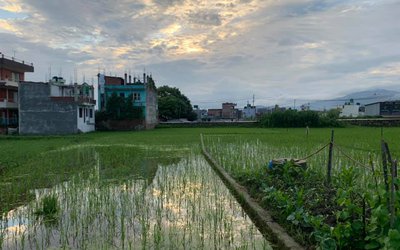
What are you looking for in Nepal?
Sustainable development is what we are mainly looking for in Nepal. We want not only to help reduce air pollution and water pollution, ground pollution and climate change, but also to bring all of these together in sustainable ways to fit in with the overall scheme of improving the quality of life of the people of Nepal. Sustainability includes economic viability, access to energy for all – especially to electricity – and the capacity to increase food production and food security in the region.
How do you distinguish your organization from others?
The way we work goes beyond coming to a country to make air pollution measurements, publishing scientific papers, and handing over the results to the government for them to take the next steps, before moving on to the next place to make more measurements. We have been engaging policymakers and the public in our research from the beginning, because we want to work in a way that helps Nepal to build the capacity for ongoing measurements, monitoring, understanding the pollution sources and developing mitigation measures, especially against air pollution. From the outset, we have been meeting and working together with government officials from ministries and departments, as well as with people from media and civil society. We try to get a broader understanding of where Nepal’s air pollution fits in as a priority in the various issues considered in the country’s development.
How do you carry out the program?
Our work here includes a number of science policy dialogues and awareness raising programs. We have held meetings with a number of parliamentarians, academics and several others from various sectors. Through these interactions we have gained a general awareness not only about air pollution issues, but also how they connect with other issues.
Alongside NAST, are you also working with others?
We are also working closely with research communities here, especially with ICIMOD as well as with partner universities. We are supporting capacity building. ICIMOD, for instance, has built up an atmospheric initiative program in close collaboration with our efforts here.
Since you have signed an agreement with NAST, what will be the longer term implications for both organizations?
Our agreement with the Nepal Academy for Science and Technology (NAST) aims to ensure that what we do in Nepal fits into the overall science and technology work done in Nepal. As I said before, we have very good individual collaborative ties with organizations like ICIMOD. But of course, NAST is the umbrella organization. We hope that the collaboration with NAST will allow us to really find where our work fits in best in the Nepalese research communities.
How does NAST benefit?
We also have larger overarching collaborations. One is with the international coalition the Climate and Clean Air Coalition (CCAC). This is a voluntary organization with currently fifty member states and about 60 non-state members, and the IASS is one of those members. Similarly, ICIMOD is another non-state member. IASS is represented on the steering committee by my colleague Dr. Birgit Lode. The IASS is very active. We will bring our connections to international institutions and important global coalitions such as these into the Nepalese community through our collaboration with NAST.
As you said, you have met with government officials, scientific communities and parliamentarians, how do you find their awareness level regarding air pollution in the Kathmandu Valley?
Our interaction with Nepalese policymakers changed one thing. It did not change the structure. But what changed is the information that has been available. Of course, structures like the Department of Environment, the Department of Transport Management, and the ministries have their own responsibilities. In our early interaction with the officials of various departments and with others, we came to realize that effective mitigation measures were not really feasible at that time in 2012, largely because our scientific understanding of the causes and impacts of air pollution was far from adequate to design science-informed mitigation measures. Although the air pollution has been talked about for a long time, there were no organized studies or single coordinating institution set up for dealing with issues related to air pollution. There was a small air quality monitoring program with six stations in the Kathmandu Valley, but it was discontinued after 2008.
Don’t you think Nepal has any measurements on air quality?
Although there have been such measurements in the past, they are not enough to determine the main sources of the pollution and their fractional contributions to air quality in the Valley and other parts of Nepal. If you look outside and go for walk, you see the diesel trucks with fumes; you see the brick kilns and black fumes. You see trash fires and you see the agricultural waste burning and fumes from kitchen stoves coming from houses. But we don’t have the information to determine if the diesel trucks are responsible for two percent of the pollution or 20 percent of the pollution, if the traditional cook stoves are contributing one percent or 40 percent, etc. . The same applies to brick kilns and all other sources: we just don’t know how much of the pollution each of these are causing. To figure this out, we have to first carefully measure and monitor the pollution.
How can you provide support?
We mobilized the capacity to bring in instrumentations and scientists from many research institutions across the globe, adding to the efforts from our side and from ICIMOD’s side. My colleague Dr. Maheswar Rupakheti, who worked earlier for UNEP’s Project Atmospheric Brown Cloud (ABC), headquartered in the Asia Pacific office, has been leading our work in Nepal since May 2012. I have been working on air pollution issues in South Asia since the mid-1990s. We have very good contact with these communities and we can communicate to others about Nepal’s data gap and knowledge requirements with respect to air pollution.
Have you done any measurements?
Based on our discussions with the research community, twenty research institutions from Europe, Asia and the United States joined us in 2013 to carry out an air pollution measurement campaign with a focus on the Kathmandu Valley, which turned out to be the second largest international air pollution measurement campaign ever carried out in South Asia. The campaign has collected air quality and other atmospheric data of unprecedented detail in the Kathmandu Valley and surrounding regions. The team of scientists stayed in Kathmandu for six months for these measurements, and based on their work we can now shed some light on different sources and other factors that lead to severe air pollution in the Kathmandu Valley. An initial analysis has given us an understanding of many things, such as the average level of various pollutants throughout the year, the contributions of brick kilns, diesel vehicles, and the burning of agricultural and household waste. The contributions of these sources vary significantly from season to season, and from location to location. For instance, brick kilns operate on a seasonal basis, from around mid-December to mid-April. We are very close to quantifying these figures. We would like to share this vital information with the structures that the government has set up. Once they have the information they need on sources and appropriate measures to mitigate, they can activate various policies and regulations and take action to control air pollution.
We have been talking too much about the air pollution of the Kathmandu Valley. As a scientist, how do you see the situation all over Nepal? Having two big industrialized nations as neighbors, how do you see the state of pollution?
Nepal has tremendous air pollution problems throughout the country. It is especially visible in the Kathmandu Valley due to the valley’s large sources of pollution and its bowl-like shape, which is conducive to the build-up of air pollution. A lot of air pollution is likely to be local pollution from within the valley. There are substantial pollution problems across Nepal, the precise sources of which are yet to be quantified as part of Nepal’s pollution comes from sources in the wider region, including India, China, and other countries, while the rest is produced locally. Take the case of Lumbini, which we visited last week, where air pollution levels are very bad and have worsened rapidly since the 1990s. Before that, it was a beautiful clean area – you could see the Himalayas from there. Now normally you hardly see the sun for weeks at a time. This is the result of three major factors. First, pollution is coming from across the Nepal-India boarder, i.e., from the Indo-Gangetic Plain with its huge population and numerous polluting activities, including the burning of petrol, diesel, coal and so on. Second, there is a local factor. For instance, there are some sixty factories between Bhairahawa Airport and Lumbini, including brick kilns, clinkers and others. These factories produce substantial amounts of pollution. The third factor is the burning of waste in general and of agricultural waste in particular. Agricultural waste burning is a huge source of air pollution.
How will it impact climate change?
Some air pollutants are also a cause of climate change. We also need to look into the air pollution-climate change link in the context of global warming, which is due to greenhouse gases such as CO2, but also due to pollutants like methane, ozone and black carbon (in soot). Every country needs to make an effort to decarbonize their economy, and major emitters especially need to reduce their output substantially. As I have already mentioned, Nepal has the perfect opportunity to work with the Climate and Clean Air Coalition, which can help Nepal with the mitigation especially of air pollutants which contribute to climate change, and can also spread information on the difficult situation on Nepal, providing further encouragement for international collaboration on mitigation.
Although Nepal is an LDC with a very negligible contribution of CO2, Nepal has expressed its commitment to take certain mitigation measures. In this sense, how will your project help Nepal?
Yes, Nepal’s CO2 emission is quite small. However, it is important for countries like Nepal to make efforts towards getting away from fossil fuels as their combustion produces harmful gases such as sulfur dioxide and nitrogen oxide, as well as particulate matter. Geting away from fossil fuel use shows international solidarity, and encourages other countries or larger emitters to proportionately reduce their emissions. Along with pollution impacts, there also is the need to reduce fossil fuel use because of national security – consider the long fuel lines in Nepal at the moment. As Nepal is not a producer of fossil fuel, it imports them. The tremendous potential for hydropower could make Nepal more energy independent.
Reducing air pollution also helps lessen the impacts of climate change. There are several air pollutants, especially methane, ozone and black carbon which have strong climate impacts. Our measurements show tremendous levels of ambient black carbon, reaching even up to the Himalayas. Colleagues from Italy have been doing research for over a decade at the Pyramid Station near the Everest base camp, where they measure the level of black carbon in the air. According to their study, up to 5 micro grams per cubic meter are recorded at Pyramid site. This level is comparable to crowded European cities like Berlin, Paris or London. Some of this pollution comes from Nepal and some of from the broader region outside Nepal, i.e., transported from other countries in southern Asia.
How do you view the current level of air pollution?
Air pollution is terrible in Nepal, as everyone will notice once they are in the town. Air pollution impacts the climate, but the key to focus on is its effects on human health. The World Health Organization estimates that 30,000 premature deaths every year in Nepal are attributed to air pollution. Air pollution is the largest environmental health risk, more than the lack of clean water and sanitation facilities. This is a tremendous amount of pressure on public health and the economy. Consider how much pressure hospitals are facing on their cardiovascular units and respiratory units. Air pollution also contributes to nervous system disorder, as well as to causing cancer. It causes all sorts of health impacts and can rob people of their quality of life and ability to work. Air pollution also contributes to loss of visibility, and impacts on tourism. This wide range of effects means that air pollution is a challenge for nearly everyone in Nepal, and we hope that our efforts together can help to reduce it over the coming years.

Keshab Poudel
Poudel is the editor of New Spotlight Magazine.
- FOURTH PROFESSOR Y.N. KHANAL LECTURE: Nepal-China Relations
- Jun 23, 2025
- Colonel JP CROSS: Centenary Birthday
- Jun 23, 2025
- REEEP-GREEN: Empowering Communities with MEP
- Jun 16, 2025
- BEEN: Retrofitted For Green
- May 28, 2025
- GGGI has been promoting green growth in Nepal for a decade: Dr. Malle Fofana
- May 21, 2025















